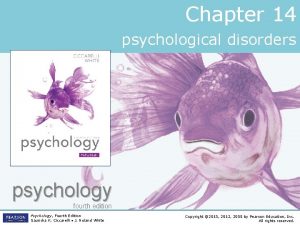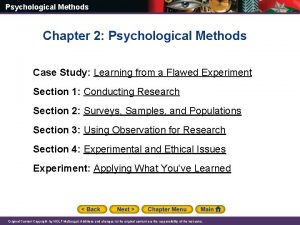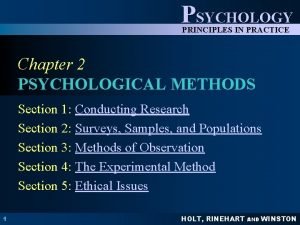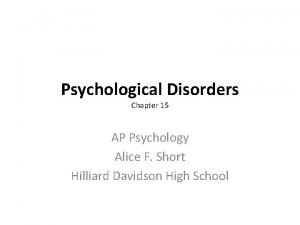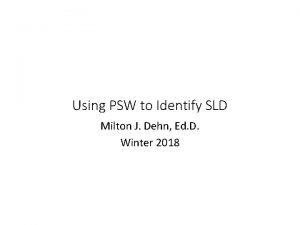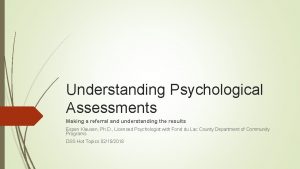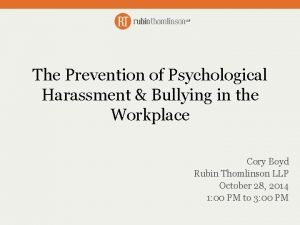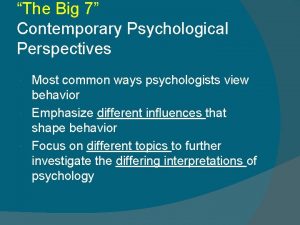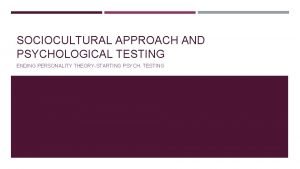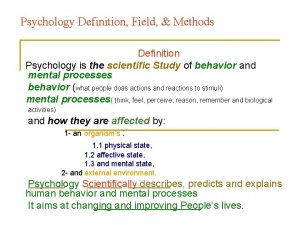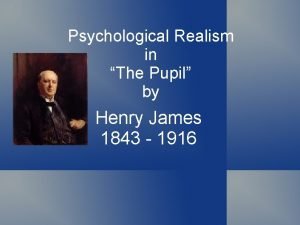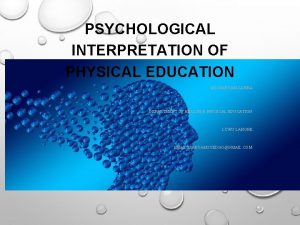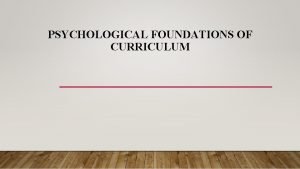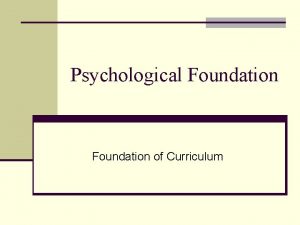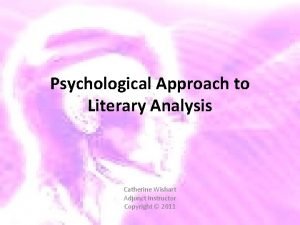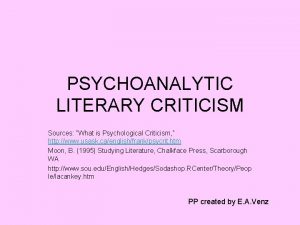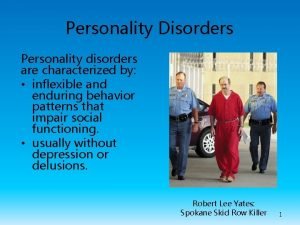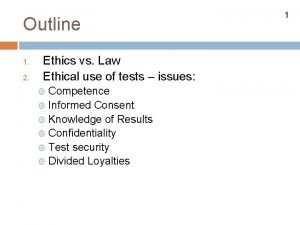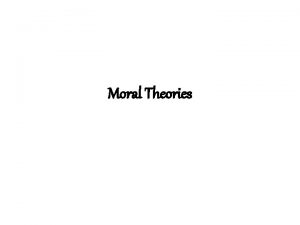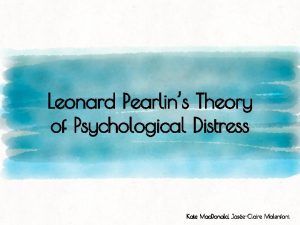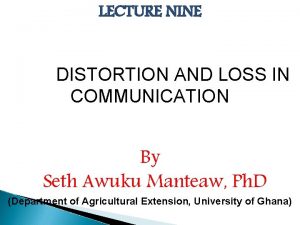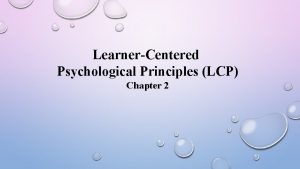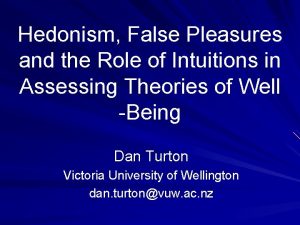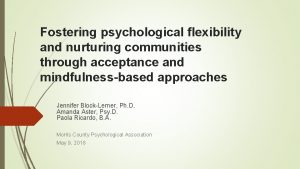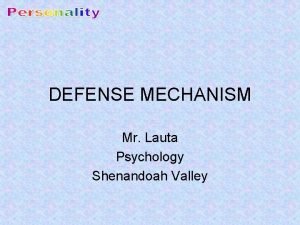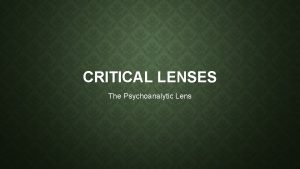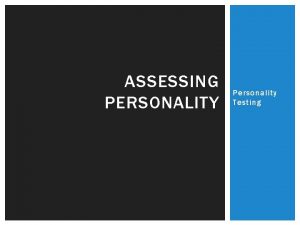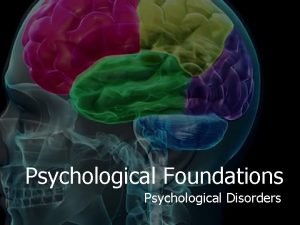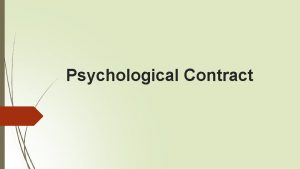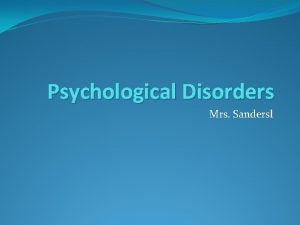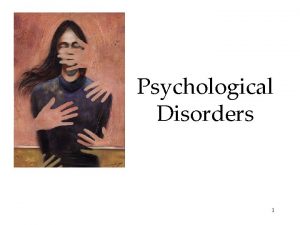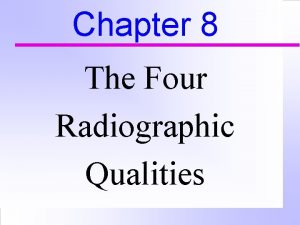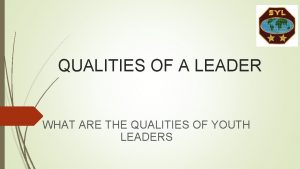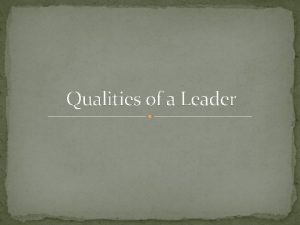Chapter 10 Personality Personality Personality Psychological qualities that























































- Slides: 55

Chapter 10 Personality

Personality • Personality – Psychological qualities that bring continuity to an individual’s behavior in different situations and at different times.

Psychodynamic Theories • Psychoanalysis– Freud’s system of treatment for mental disorders. -Identifies unconscious thoughts and emotions and brings them to consciousness.

Psychoanalytic Theory • Freud’s theory that relates personality to the interplay of conflicting forces within the individual.

Freud’s Psychoanalytic Theory • Unconscious – Psychic domain of which the individual is not aware, but which is the storehouse of repressed impulses, drives, and conflicts that are unavailable to consciousness.

Freud’s Psychoanalytic Theory • Drives and instincts Eros Libido Thanatos

Freud’s Psychoanalytic Theory • Drives and instincts Eros Libido Thanatos Drives people toward acts that are sexual, life-giving, and creative.

Freud’s Psychoanalytic Theory • Drives and instincts Eros Libido Thanatos Drives people to experience sensual pleasure.

Freud’s Psychoanalytic Theory • Drives and instincts Eros Libido Thanatos Drives people toward aggressive and destructive behaviors.

Freud’s Psychoanalytic Theory • Personality structure Id Superego Ego

• ID – Needs, drives, instincts, and repressed material. • EGO – In touch with reality; strives to meet the demands of the id and superego in “socially acceptable ways. ” • SUPEREGO – Conscience; counteracts the socially undesirable impulses of the id.

The Unconscious Mind • ID – PLEASURE PRINCIPLE • EGO – REALITY PRINCIPLE • SUPEREGO – MORAL PRINCIPLE

Freud’s Model of the Mind


Freud’s Psychoanalytic Theory • Psychosexual stages – Successive, instinctive patterns of associating pleasure with stimulations of specific bodily areas at different times of life. Oral Stage Anal Stage Phallic Stage Latency Genital Stage

Freud’s Psychoanalytic Theory • Oedipus complex – According to Freud, a largely unconscious process whereby boys displace an erotic attraction toward their mother to females of their own age and, at the same time, identify with their fathers.

Freud’s Psychoanalytic Theory • Identification – The mental process by which an individual tries to become like another person, especially the same-sex parent.

Freud’s Psychoanalytic Theory • Penis envy– According to Freud, the female desire to have a penis – a condition that usually results in their attraction to males.

Freud’s Psychoanalytic Theory • Fixation– Occurs when psychosexual development is arrested at an immature stage. Oral Fixations

Freud’s Psychoanalytic Theory • Ego defense mechanisms – Largely unconscious mental strategies employed to reduce the experience of conflict or anxiety. 8 Defense Mechanisms: – Repression – Denial – Rationalization – Reaction formation – Displacement – Regression – Sublimation – Projection

1. Repression: excluding unacceptable thoughts from awareness. 2. Denial: avoiding a difficult situation by pretending it doesn’t exist. 3. Rationalization: giving socially acceptable reasons for unacceptable behaviors. 4. Reaction formation: acting the opposite of how you actually feel.

5. Displacement: shifting your reaction from the real source of your distress. 6. Regression: adopting childlike behaviors that were effective ways of dealing with stress as a child. 7. Sublimation: gratifying sexual or aggressive desires in ways that are socially acceptable. 8. Projection: attributing our own unconscious desires to other people.

Freud’s Psychoanalytic Theory • Projective tests – Personality assessment instruments based on Freud’s concept of projection. – Thematic Apperception Test (TAT) – Rorschach inkblot technique

Thematic Apperception Test (TAT) A projective test requiring subjects to make up stories that explain ambiguous pictures.

Rorschach Inkblot Test A projective test requiring subjects to describe what they see in a series of 10 inkblots.

NEO-FREUDIANS • • Carl Jung Karen Horney Alfred Adler Gordon Allport Abraham Maslow Carl Rogers Albert Bandura

Carl Jung • Personal unconscious – Portion of the unconscious corresponding roughly to Freud’s id. • Collective unconscious – Jung’s addition to the unconscious, involving a reservoir for instinctive “memories” including the archetypes, which exist in all people.

Carl Jung: Extending the Unconscious • Archetypes Animus Anima Shadow

Carl Jung: Extending the Unconscious • Archetypes Animus The male archetype Anima The female archetype Shadow

Carl Jung: Extending the Unconscious • Archetypes Animus Anima Shadow Archetype representing the destructive and aggressive tendencies we don’t want to recognize in ourselves.

Carl Jung: Extending the Unconscious • Introversion – The Jungian dimension that focuses on inner experience– one’s own thoughts and feelings, making the introvert less outgoing and sociable than the extrovert. • Extraversion – The Jungian personality dimension involving turning one’s attention outward, toward others.

Karen Horney – Thought Freud exaggerated the role of sex drives in human behavior and misunderstood sexual motives of women. – Developed feminine psychology.

Karen Horney: A Feminist Voice in Psychodynamic Psychology • Basic anxiety – An emotion that gives a sense of uncertainty and loneliness in a hostile world and can lead to maladjustment. • Neurotic needs – Signs of neurosis in Horney’s theory; these ten needs are normal desires carried to a neurotic extreme.

Horney’s 10 Neurotic Needs 1. Need for affections and approval 2. Need for a partner; dread of being left alone 3. Need to restrict one’s life and remain inconspicuous 4. Need for power and control over others 5. Need to exploit others 6. Need for recognition or praise 7. Need for personal admiration 8. Need for personal achievement 9. Need for self-sufficiency and independence 10. Need for perfection

Alfred Adler Individual Psychology • Inferiority Complex – An exaggerated feeling of weakness and inadequacy which stems from childhood. • Compensation – Making up for one’s real or imagined deficiencies.

Humanistic Theories • Humanistic Theories include: – Gordon Allport’s trait theory – Abraham Maslow’s self-actualizing personality – Carl Roger’s fully functioning person

Gordon Allport and the Beginnings of Humanistic • Traits – Stable personality characteristics that are presumed to exist within the individual and guide his or her thoughts and actions under various conditions. – Central traits form the basis of personality. – Secondary traits include preferences and attitudes. – Cardinal traits define peoples lives.

Abraham Maslow and the Healthy Personality • Selfactualizing personalities – Healthy individuals who have met their basic needs and are free to be creative and fulfill their potentials.

Carl Rogers’s Fully Functioning Person • Fully functioning person – Term for a healthy, self-actualizing individual, who has a self-concept that is both positive and congruent with reality.

Carl Rogers’s Fully Functioning Person • Phenomenal field – Our psychological reality, composed of one’s perceptions and feelings. • Unconditional positive regard – Love or caring without conditions attached.

Evaluating Humanistic Theories • Positive psychology – Movement within psychology focusing on the desirable aspects of human functioning, as opposed to an emphasis on psychopathology.

Bandura: Social Learning • Observational learning – Process of learning new responses by watching the behavior of others. Bo. Bo Doll Experiment

Reciprocal Determinism Cognition Environment Behavior • Process in which the person, situation, and environment mutually influence each other.

Locus of Control • Locus of control – An individual’s sense of where his or her life influences originate. – Internal vs. External • Julian Rotter

What Persistent Patterns are Found in Personality? Another approach describes personality in terms of stable patterns known as temperaments, traits, and types.

Personality (Hippocrates) • Humors – Four bodily fluids that, according to ancient theory, control personality by their relative abundance. Blood (cheerful) Phlegm (cool) Black Bile (depressed) Yellow Bile (angry)

Personality and Temperament • Temperament – Basic, pervasive personality dispositions that are apparent in early childhood and establish the tempo and mood of an individual’s behaviors.

Patterns in Personality • The “Big Five” traits 1. 2. 3. 4. 5. • Big 5 - Psych Central Openness to experience Conscientiousness Extraversion Agreeableness Neuroticism Cattell identified 16 personality factors

Assessing Traits • NEO-PI (Big Five Inventory) • MMPI-2 (Minnesota Multiphasic Personality Inventory) • Reliability and validity are important attributes of good psychological tests!

The MMPI-2 • 567 True/False Questions • Originally developed to identify psychiatric disorders. Sample Questions: • I have a good appetite. • Sometimes I like to stir up some excitement. • I work under a great deal of tension. • I often think people are watching me. Description What is Measured No. of Items Hypochondriasis Concern with bodily symptoms 32 Depression Depressive Symptoms 57 Hysteria Awareness of problems and vulnerabilities 60 Psychopathic Deviate Conflict, struggle, anger, respect for society's rules 50 Masculinity/Femini nity Stereotypical masculine or feminine interests/behaviors 56 Paranoia Level of trust, suspiciousness, sensitivity 40 Psychasthenia Worry, anxiety, tension, doubts, obsessiveness 48 Schizophrenia Odd thinking and social alienation 78 Hypomania Level of excitability 46 Social Introversion People orientation 69

Traits and the Person-Situation Debate • Person-situation controversy – Theoretical dispute concerning the relative contribution of personality factors and situational factors in controlling behavior.

Patterns in Personality • Type – Especially important dimensions or clusters of traits that are not only central to a person’s personality but are found with essentially the same pattern in many people. – Myers-Briggs Type Indicator (MBTI)

The Myers-Briggs Test Characterizes personality on 4 different scales: 1. Extraversion vs Introversion 2. Intuition vs Sensing 3. Feeling vs Thinking 4. Judging vs Perceiving

Implicit Personality Theories • Implicit personality theories Assumptions about personality that are held by people to simplify the task of understanding others. • Fundamental attribution error (FAE) Assumption that another person’s behavior (especially undesirable behavior) is the result of a flaw in the personality, rather than in the situation.

Personality Across Cultures • Assumptions people make vary widely across cultures–depending especially on whether the culture emphasizes individualism or collectivism. • Other cultural differences involve: – Status of different age groups and sexes – Romantic love – Stoicism – Locus of control – Thinking vs. feeling
 Phân độ lown
Phân độ lown Block nhĩ thất độ 2 type 1
Block nhĩ thất độ 2 type 1 Thơ thất ngôn tứ tuyệt đường luật
Thơ thất ngôn tứ tuyệt đường luật Thơ thất ngôn tứ tuyệt đường luật
Thơ thất ngôn tứ tuyệt đường luật Walmart thất bại ở nhật
Walmart thất bại ở nhật Tìm vết của đường thẳng
Tìm vết của đường thẳng Hãy nói thật ít để làm được nhiều
Hãy nói thật ít để làm được nhiều Tôn thất thuyết là ai
Tôn thất thuyết là ai Gây tê cơ vuông thắt lưng
Gây tê cơ vuông thắt lưng Sau thất bại ở hồ điển triệt
Sau thất bại ở hồ điển triệt Define personality psychology
Define personality psychology Chapter 18 psychological disorders
Chapter 18 psychological disorders Chapter 18 psychological disorders
Chapter 18 psychological disorders Chapter 14 psychological disorders
Chapter 14 psychological disorders Single blind study
Single blind study Psychology principles in practice
Psychology principles in practice Chapter 14 psychological disorders
Chapter 14 psychological disorders Ap psychology chapter 15 psychological disorders
Ap psychology chapter 15 psychological disorders Chapter 4 personal and professional qualities
Chapter 4 personal and professional qualities Chapter 4 personal and professional qualities
Chapter 4 personal and professional qualities Mn sld regression table
Mn sld regression table Referral question example
Referral question example Misic psychological test
Misic psychological test Marsh et al
Marsh et al Psychological noise
Psychological noise 7 psychological perspectives
7 psychological perspectives Psychological testing examples
Psychological testing examples Define psychological field
Define psychological field Psychological thrillers definition
Psychological thrillers definition The pupil henry james analysis
The pupil henry james analysis Psychological interpretation of physical education
Psychological interpretation of physical education Learning is explained in terms of wholeness of the problem
Learning is explained in terms of wholeness of the problem Behaviorism curriculum
Behaviorism curriculum Psychological first aid
Psychological first aid Outline one psychological explanation of schizophrenia
Outline one psychological explanation of schizophrenia Psychological approach in literature
Psychological approach in literature Psychological testing examples
Psychological testing examples Psychoanalytic literary criticism examples
Psychoanalytic literary criticism examples Postpartum psychological adaptation
Postpartum psychological adaptation Psychological egoism joel feinberg
Psychological egoism joel feinberg Group c personality disorders
Group c personality disorders The barnum effect
The barnum effect Beljan psychological services
Beljan psychological services Sfeedtest
Sfeedtest Utilitarianism vs deontology
Utilitarianism vs deontology Leonard pearlin theory of psychological distress
Leonard pearlin theory of psychological distress Psychological noise.
Psychological noise. 14 learner centered psychological principles
14 learner centered psychological principles Ksu counseling and psychological services
Ksu counseling and psychological services Noise occurs when communicators apply
Noise occurs when communicators apply Leonard pearlin theory
Leonard pearlin theory Psychological hedonism
Psychological hedonism Psychological flexibility
Psychological flexibility Rationalization defense mechanism examples
Rationalization defense mechanism examples Psychoanalytic lens
Psychoanalytic lens Psychological barries
Psychological barries













